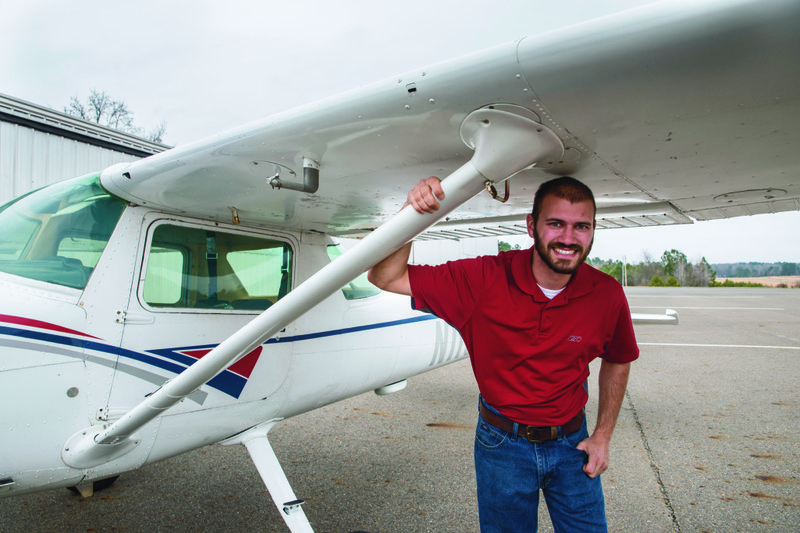Who says you can’t learn to fly in Magnolia? With the latest personnel addition to the city’s Municipal Airport at Ralph C. Weiser Field, anyone wishing to propel through, above, or below the clouds in an aircraft now has the chance.
Since November, licensed pilot and south Arkansas native Brad Ham has worked as the airport’s manager. Aside from his duties as the everyday overseer of the property located approximately one mile south of Magnolia’s city limits, he also holds the title of flight instructor. Now, anyone wishing to get some air time — quite literally — has the chance.
Ham is a 2008 graduate of El Dorado High School, where he took advantage of the Murphy El Dorado Promise, a local scholarship program sponsored by Murphy Oil that helps longtime El Dorado school system students attend college at a significant discount, then attended Henderson State University.
At the Arkadelphia institution, known for its civilian flight program, Ham graduated in 2013 with an emphasis in aviation and a private pilot’s license. With the certification, he could only fly anyone other than himself, for no payment received.
“As a private pilot, you can fly your own airplane or a rented one,” he said, “or you can fly your family or friends or whomever – you just can’t do it for compensation.”
While in college, Ham also worked summers at El Dorado’s South Arkansas Regional Airport. After graduation, he continued there until he came to Magnolia late last year. As a ground employee at the Union County airport, his love for aviation was again sparked after a cruise in an acquaintance’s Beechcraft King Air twin-turboprop craft.
“That got me hooked again,” he said. “I knew I wanted to fly again, so I had to bite the bullet and get back to it.”
In 2016, Ham went back to flight school and received his instrument rating from Little Rock’s Central Flying Service. The rating trained him to fly solely on the instrumentation of the aircraft, and rely less, or not at all, on eyesight alone. The following year, he attained his commercial pilot’s license from El Dorado’s Union Aviation and became a certified flight instructor in August.
“I plan on going back to Henderson next month and getting my twin-engine rating, for multi-engine planes,” he added.
Jet ratings, or jet types, Ham said, are specific to each model aircraft. No one license covers all large planes. Any craft that is either a turbine jet or any airplane with a gross weight over 12,500 pounds, requires a type rating.
As a private pilot with his current rating, the airport manager and instructor is able to fly any one-engine small plane made. The Cessna 150, which Ham flies regularly and instructs most students in, falls into that category. The rock-solid aircraft, he says, is perfect for beginner aviators.
“It’s a great trainer airplane,” he said. “It’s a little slow, but it’s really forgiving, it’s easy to learn in, and it’s very reliable; it’s just a great and a great running airplane.”
The Cessna — which is held in one of the dozen or so hangar slots at Magnolia’s airport — like all of its brethren, has to meet FAA regulations and pass strict regular yearly inspections. And even as the 150 may be an older plane, like most Cessna’s still out flying today, under the hood, the guts and bolts of the aircraft are, in essence, fresh off the assembly line.
“This one just had an engine overhaul,” Ham said. “It’s practically brand new. It also has a new carburetor, a new prop, and new brakes. The only thing still original on the plane is the interior.”
Flying is not an activity where time-off is helpful. Ham said he flies almost every day and that if he didn’t, even for a relatively short period, his skills are noticeably rusty at first.
“If you take even a week or two off, you can feel it when you get back in the airplane,” he said.
For students to obtain a private pilot’s license, they typically require anywhere from 40 to 60 hours in the air, behind the stick. In real time, those hours are usually gained in three months to a year, Ham said. It all just depends on the student and how much time is spent in the skies.
“It’s a highly perishable skill,” he added. “I always recommend people try to come at least twice a week.”
The peak, and probably the best season for beginners to learn basic aviation skills comes after the winter, especially in Arkansas, where long, clear, cloudless days are routine for much of the late spring, summer, and autumn months. But even on cold, gray days, certain flight skills can still be taught.
“The weather can get in the way,” Ham said. “But we could go out and practice landing and take-offs and traffic patterns.”
The new airport manager and instructor, among his day-to-day maintenance and office duties, also wants to host more public-friendly events at the facility. He brought forth the concept of reconnecting with Magnolia’s Blossom Festival, that for so many years in the early days of the town celebration held a weekend gathering at the airport.
“We’d like to maybe hold a fly-in, or some kind of event out here on that Sunday,” he said, “Something just to spread the word and get more people into the airport and get the community involved.”
He also said business “comes through the air,” so a well-run, well-supported, active airport is always a plus.
With the aviation bug now a career, the El Dorado native ultimately aspires to attain enough hours and certifications for a pathway to major commercial aviation. The airlines can pay six-figures, plus there’s a current job-market shortage. But staying in southwest Arkansas may be a fit also.
“I like living here,” Ham said. “I like Magnolia. I like my hometown. If I could find the right situation, I wouldn’t mind that either.”

